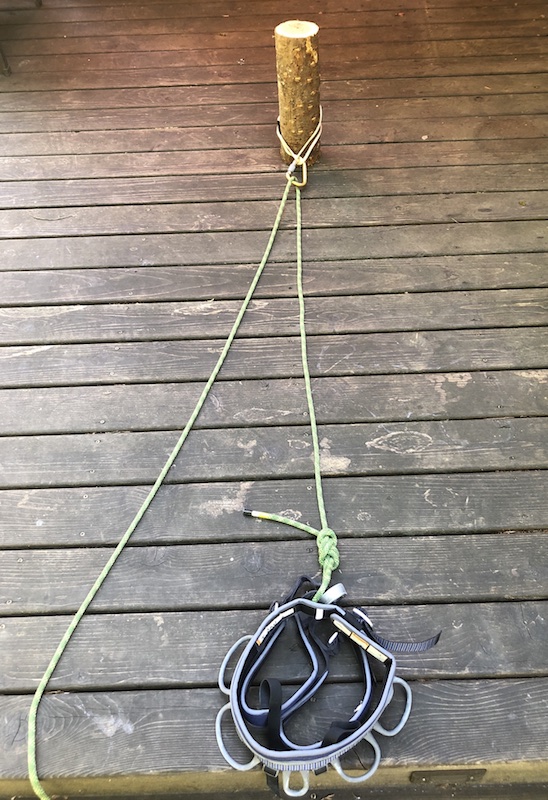Use the rope to extend your anchor to a cliff edge
Scenario: you’ve finished leading a pitch, and find yourself on a big ledge. You see nothing near the edge to use for an anchor, but about 15 feet / 5 meters back from the edge, there’s a nice big tree. You want to build an anchor on the tree, but then belay from the edge of the cliff. Being on the cliff edge lets you see your partner, minimize rope drag, have better belay communication, and who knows, maybe even toss the occasional pebble at them if they’re making it look too easy. =^)
Here’s one of several ways to rig this (and no, you thankfully don't need a heap of 1 inch webbing!) This assumes you have at least 30 feet . 10 meters of rope left after your lead.
Walk over to the tree, put a sling or cordelette around it, clip a locking carabiner or two to the sling, and clip the rope through the carabiner(s). Walk back toward the cliff edge. You’re still on belay the entire time.
(You could skip the sling and carabiner and just walk around the tree, assuming you can easily do this, and the tree is not going to get evil tree sap on your rope. If it’s a conifer tree, a sling might be a better choice.)
When you get close to the edge about where you want to belay, pull up a few feet of slack, and tie an overhand on a bight using BOTH strands of the rope. (This is known in some corners of the climbing world as a Big Honkin’ Knot, or “BHK”.)
Done! 1) You’re fixed to the anchor. 2) it positions you nicely on the edge so you can watch your partner, and 3) it gives you a nice master point from which you can belay your second or set up a hauling system on a big wall. (Note the ATC Guide clipped to the overhand loop, ready to belay up the second.)
What about a more exposed location?
The example above assumes a pretty large, flat ledge that you can't fall off of. If you need to approach something that is maybe downward sloping, loose rocks etc. with more chance of a potential fall, here are a couple of options.
Rigging option #1: Put a Munter hitch on the anchor, and sort of belay yourself as you walk to the edge (while remaining on belay from your partner the entire time.)
Rigging option #2: Back yourself up with a friction hitch on the backside of your clove hitch. (This might sound like a lot of fussy steps, but it's quite simple.)
Build your anchor on the tree.
Estimate how far you want to stand from the tree; in this case let's say it's 5 meters.
Pull up about 7 meters of rope.
Tie a clove hitch onto the anchor. You are now secure to the anchor, with 7 meters of rope between you and the tree.
Tie a friction hitch onto the backside of your clove hitch and clip the friction hitch to your belay loop with a locker.
Carefully walk to your chosen belay spot, sliding the friction hitch along the rope.
With the extra 2 meters of rope, tie a butterfly above you. Clip your belay device to this, pull up the slack rope, put your partner on belay.
If you need to fine-tune your position by shortening the rope a bit, you can tie an overhand on a bight to take up some of the extra rope, then remove the friction hitch.
One caution, because of the dynamic rope, keep in mind that if your second takes a big fall, the rope might stretch enough to potentially pull you over the edge. Try to keep a tight rope on your second when belaying, use an auto locking belay device such as a Black Diamond ATC guide, and try to brace your feet a bit on something if possible.
One other possible enhancement: If you have any concern about your ropes running over a sharp edge, or rockfall onto them, or if they might get damaged in anyway, or if redundancy simply gives you a warm fuzzy feeling, you could tie an overhand on a bight and clip it to the anchor point, giving you two redundant strands.
Here's a short Instagram video from Swedish guide Nikki Hammarstrom showing how it's done. (Note the pine tree - if there is any visible sap on it it's probably better to use a sling rather than your rope.)
Here’s a related technique that's more suitable when using double ropes. Put both strands of rope through the anchor, walk back to the edge, tie a double overhand loop for the belay, tie another a double overhand loop and clip it to your harness. See photo below, contributed by Alex Kostadinov; thanks Alex!
photo: Alex kostadinov
A reader mentioned to me that there is an excellent article about this at climbing.com, called “belay extensions.” Read it here.
This technique can also be used for big wall climbing, to rig a hauling a point to minimize friction.
True life story: my partner and I had topped out on The Prow, a classic big wall route in Yosemite. The last pitch concluded in a series of fourth class ledges. We set up our anchor on a tree above the ledges that made our hauling absolutely miserable from all the extra friction. Following us on the route were a team of two New Zealand mountain guides. Their leader finished, went to a nearby tree, rigged the anchor exactly as shown above, walked back down to a low-friction place to haul, and set up his hauling system directly on the overhand loop. He got his bag to the top with minimal cursing and MUCH faster than we did. Lesson learned!




